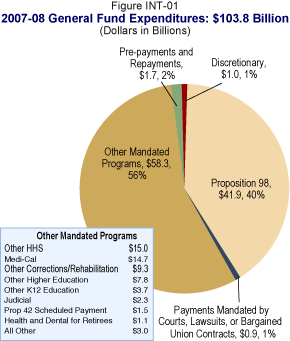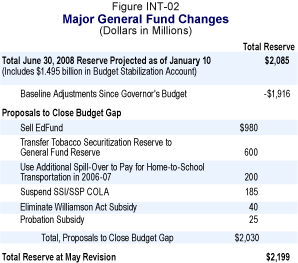|
|
 |
Introduction
The Governor's Budget for 2007-08, as proposed in January, eliminated the net operating deficit (the balance between ongoing revenues and expenditure, after accounting for various one-time revenues and expenditures, most significantly the $1.6 billion that was proposed to pre-pay the Economic Recovery Bonds [ERBs]), held spending growth to 1.0 percent and maintained a reserve of $2.1 billion.
The May Revision continues the Governor's commitment to restraining the growth in spending, pre-paying debt, eliminating the net operating deficit, not raising taxes and maintaining an adequate reserve. As such, the Governor's May Revision includes several measures to further reduce spending, generate additional revenues from publicly-owned assets and provide a reserve of $2.2 billion.
While the net operating deficit of $1.4 billion is not eliminated entirely even with these changes, this reflects major progress as compared to the $4.4 billion that was anticipated for 2007-08 at the time the Governor signed the 2006 Budget Act and reflects a reduction of 92 percent from the projected deficit when the Governor took office.
RESTRAINING SPENDING GROWTH WHILE PROTECTING PRIORITIES
The May Revision proposes to increase General Fund expenditures in 2007-08 by $1.5 billion or 1.5 percent over the level of spending in 2006-07. As Figure INT-01 shows, most General Fund spending is non-discretionary. Of the total spending proposed, $1.7 billion, or 2 percent, is for pre-paying debt and only $1.0 billion, or less than 1 percent is proposed for policy choices. The remainder is required either by the constitution, federal laws, statutory entitlements, binding labor agreements or court orders.

Click here for figure in PDF format
(pdf *
- 498K)
Consequently, the only way to hold down spending is by approving very few discretionary spending increases while changing state law to reduce the costs of programs. The Governor's Budget proposed legislation to reduce various state programs for total savings of $2.5 billion. The May Revision proposes additional program reductions for $430 million in additional savings, of which $230 million will be in the budget year, with the remainder occurring in the current year.
Despite this extreme restraint in overall spending growth, the May Revision continues to protect key priorities by fully funding the state's Proposition 98 obligation to education, fully funding the Governor's compacts with higher education and the judiciary, fully funding public safety, continuing the commitment to reform the prison system and protecting economic growth by not raising taxes.
SUMMARY OF MAJOR GENERAL FUND CHANGES
Figure INT-02 below reflects major General Fund changes since the Governor's Budget was released in January.

Click here for figure in PDF format
(pdf *
- 412K)
MAXIMIZING THE VALUE OF PUBLIC ASSETS
The May Revision also reflects the administration's desire to think outside the box to find budget solutions that are beyond program reductions and tax increases. Specifically, the May Revision proposes ways to expand revenues by maximizing the value of underperforming public assets.
- The May Revision proposes the sale of EdFund - California's student loan guarantee agency. The EdFund competes in the private market as a student loan guarantor to banks and other financial institutions. EdFund does not offer direct student loans, set loan rates, or provide revenues to the General Fund. Student loan interest rates are regulated by the federal government; thus students will not be affected by this proposed transaction. Analysis shows that there is major potential for a private firm to improve earnings from the EdFund which makes EdFund an attractive public asset that could be maximized to benefit taxpayers. The May Revision assumes a net one-time increase in revenue from this sale of $980 million.
- The administration is requesting that the Legislature consider selling a long-term license to operate the state lottery. The lottery has never fulfilled its promise to provide a growing source of revenues to education and it substantially underperforms other states' lotteries. A competitively bid lease would reverse the anemic trend of current lottery sales, guarantee a steady and growing stream of revenues to education, and provide billions of dollars in additional fiscal benefits to the state's General Fund.
- While the May Revision does not rely on the proceeds from a lottery lease to balance, one potential use of the proceeds from selling a long-term license to operate the lottery would be to pay off $8 billion in outstanding ERBs. This would free up $3.1 billion in both the 2007-08 and 2008-09 budgets which otherwise will be used for debt service.
PRINTABLE BUDGET DOCUMENTS Back to Top
Revised Budget Summary - Introduction (pdf * - 37K)
-
Provides the entire Introduction Chapter in pdf format.
ADDITIONAL INFORMATION Back to Top
Proposed Budget Summary - Introduction (January 2007)
Displays Proposed Budget Summary information for Introduction.
|
 |
|